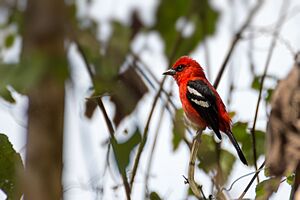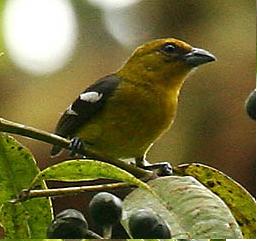White-winged tanager facts for kids
The white-winged tanager (Piranga leucoptera) is a colorful songbird found in parts of North, Central, and South America. It belongs to the cardinal family, which includes many bright red birds. This medium-sized bird is known for its striking looks and its unique white markings on its wings.
Quick facts for kids White-winged tanager |
|
|---|---|
 |
|
| Male in Venezuela | |
 |
|
| Female | |
| Conservation status | |
| Scientific classification | |
| Genus: |
Piranga
|
| Species: |
leucoptera
|
 |
|
Contents
About the White-Winged Tanager
The white-winged tanager is a type of songbird. It's part of the Cardinalidae family, which also includes cardinals and grosbeaks. Scientists group living things into families and species. This bird's scientific name is Piranga leucoptera.
Different Types of White-Winged Tanagers
There are four main types, or subspecies, of the white-winged tanager:
- Piranga leucoptera leucoptera
- P. l. latifasciata
- P. l. venezuelae
- P. l. ardens
These different types look a little bit different and live in different areas.
What Does the White-Winged Tanager Look Like?
This bird is about 13 centimeters (5 inches) long. It weighs between 13 and 20 grams (about half an ounce).
Male and Female Birds
- Males: Most male white-winged tanagers are bright red. They have a black "mask" around their eyes. Their wings are black with clear white stripes, called wing bars.
- Females: Females are usually duller. They are a yellowish-olive color. But like the males, they also have black wings with white wing bars.
- Young Birds: Baby birds look similar to the females but are even duller in color.
Subspecies Differences
Some subspecies have slight differences:
- P. l. latifasciata males are a darker red. Their females are a brighter yellow. Both sexes have wider white wing bars.
- P. l. venezuelae males have a smaller black mask than the main type.
- P. l. ardens is similar to venezuelae, but its lower wing bar is thinner.
Where Do White-Winged Tanagers Live?
White-winged tanagers live in several separate areas across North, Central, and South America.
Where Each Subspecies is Found
- P. l. leucoptera: Lives from southern Mexico down through Guatemala, Belize, El Salvador, Honduras, and into northern Nicaragua.
- P. l. latifasciata: Found in Costa Rica and western Panama.
- P. l. venezuelae: Lives in the Andes mountains of Colombia (except one part), east through Venezuela, into Guyana, and far northern Brazil.
- P. l. ardens: Found on the western side of the Andes from Colombia south to southwestern Ecuador. It also lives on the eastern side from Ecuador through Peru to Bolivia.
Their Favorite Homes
In Mexico and northern Central America, these birds like to live in pine-oak forests. They also enjoy shady coffee farms. In other areas, they prefer humid mountain forests, cloud forests, and older secondary forests (forests that have grown back after being cut down). They can also be found in coffee farms and drier forests.
They live at different heights depending on the country:
- In Mexico, they are found between 100 and 1,800 meters (330 to 5,900 feet) high.
- In Costa Rica, they live between 1,100 and 1,850 meters (3,600 to 6,000 feet) high.
- In Venezuela, they range from 650 to 2,100 meters (2,100 to 6,900 feet) high.
- In Colombia, Ecuador, and Peru, they are found between 600 and 2,000 meters (2,000 to 6,600 feet) high.
How White-Winged Tanagers Behave
What They Eat
The white-winged tanager eats fruits, berries, and seeds. They probably eat insects too. These birds usually look for food in pairs or small groups. They search in the tops of trees or at the edge of the forest. Sometimes, they join groups of different bird species that are all looking for food together.
Reproduction and Nests
Scientists have seen a female white-winged tanager building a small cup-shaped nest. She built it high up on a mossy tree branch. Not much more is known about how these birds raise their young.
Their Songs and Calls
The white-winged tanager has a thin, wiry song that sounds like "e-seé-se-whéét." They also make a variety of different calls. You can listen to their sounds online.
Conservation Status
The IUCN (International Union for Conservation of Nature) has looked at the white-winged tanager. They have decided that this bird is of "Least Concern." This means that the bird is not currently in danger of disappearing. It lives in many protected areas. Also, much of its natural home outside these areas is still healthy.


